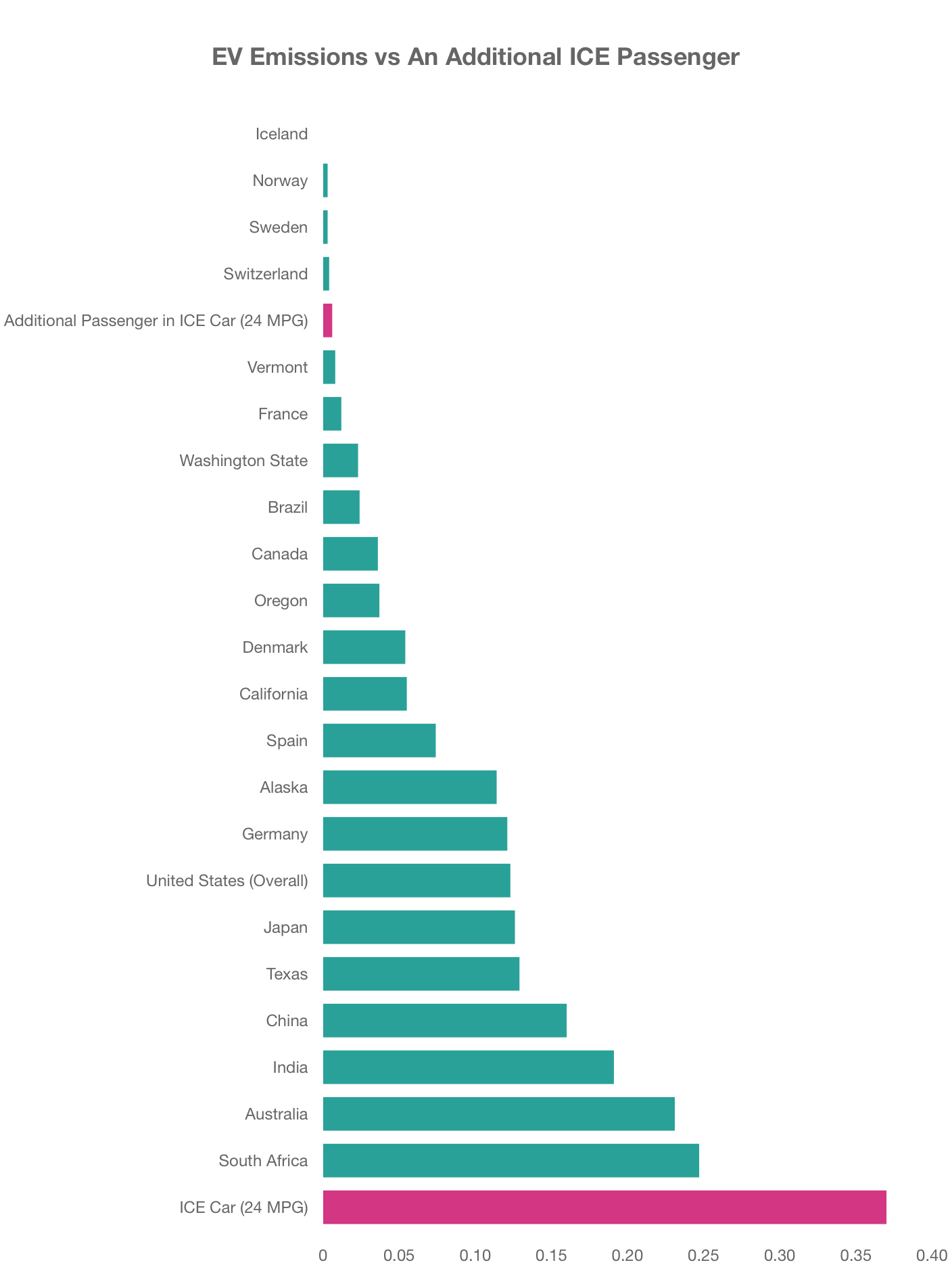An Additional ICE Passenger
My main goal in purchasing my Tesla Model 3 a couple of years ago was to reduce the amount of carbon emissions I contribute to the atmosphere. Driving an electric vehicle almost always means emitting less carbon emissions. However, there are certain scenarios, such as carpooling and public transit, that can still result in lower emissions.
One common scenario is when I have a choice between riding as a passenger in an ICE (internal combustion engine) car or driving myself in my EV (electric vehicle). So, the question is: which of these would result in lower carbon emissions?
- Riding as an additional passenger in an ICE car; OR
- Driving alone in an EV
Let’s do some quick math to try and come up with an estimate.
Carbon Emissions From an Additional ICE Passenger
The key word here is additional. The vehicle is assumed to be driving no matter if I am in it or not. So how much carbon emissions results from the additional weight I would add to the car? First, some assumptions:
- Fuel efficiency of the vehicle is 24 MPG 1
- 8.89 kg of CO2 emitted per gallon of gasoline 2
- Every 100 pounds (45 kg) of additional weight reduces MPG by 1% 3
Carbon emissions without a passenger
We can first calculate how much emissions that car would have if I was not riding in it.
1/24 gallons per mile * 8.89 = 0.370 kg of CO2 per mile
Carbon emissions with a passenger
Then, we can calculate how much emissions it would have if I was riding in it.
24 MPG * (1 - 0.01)^(68 kg / 45) = 23.638
1/23.638 gallons per mile * 8.89 = 0.376 kg of CO2 per mile
Marginal carbon emissions from passenger
The difference between those is the additional carbon emissions.
0.376 - 0.370 = 0.006 kg of CO2 per mile
Carbon Emissions From an EV
Now let’s compare that to the carbon emissions from driving an EV by myself, with no other passengers. The key point here is that this car is assumed to not be on the road if I choose to carpool with the ICE car. So we will take the entire car’s weight into consideration.
Since EVs do not emit any carbon emissions directly, we will compare the carbon emissions from the electricity grid that is used to charge the car.
How much electricity is used?
The lifetime efficiency of my Tesla Model 3 Long Range AWD is around 0.257 kWh/mile (kWh -> kilowatt hours, the same unit that is shown as the usage on your electricity bill). The vast majority of miles are from me driving by myself with no additional weight, so this seems like a good number to use.
Carbon emissions from electricity grid
This is the tricky one. The answer here depends on where you get your electricity from. The amount of emissions varies quite drastically depending on the geographic region, so we will look at multiple examples.4
The first example is my home state of Washington5, which emits a total of 0.089 kg of CO2 per kWh.
0.089 * 0.257 kWh/mile = 0.023 kg of CO2 per mile
Answer: It Depends
So what results in more carbon emissions? In this case, it depends greatly on where your electricity is coming from. As you can see in the chart below, there are plenty of countries where riding in the ICE car has less emissions, and also some countries where riding in the EV has less emissions. There is even Iceland, which emits zero carbon emissions from electricity generation.

My Take
As time goes on, all these countries will start to move further down on this chart as they transition to renewable energy, without EVs needing to change anything. Meanwhile, the ICE car will not be emitting any less emissions in the future than it did on its first mile.
Most of the energy for my car comes from the public utility Seattle City Light. Over 90 percent of their energy comes from renewable sources (mostly hydro), and the small emissions they do generate is offset every year. 5 Because of this, I try to choose driving alone in my EV over carpooling in an ICE car as much as possible.
Although I find in most situations people would much rather ride with me anyway.
-
Taken from the average fuel economy of a typical US car ↩
-
https://www.eia.gov/environment/emissions/co2_vol_mass.php ↩
-
All these examples use data from Carbon Footprint, which aggregates data from various global sources. ↩
-
Most of my electricity comes from Seattle City Light, which is far cleaner than the rest of the state and country. I could not easily find data to use on Seattle City Light, so I stuck with the entire state of Washington. ↩